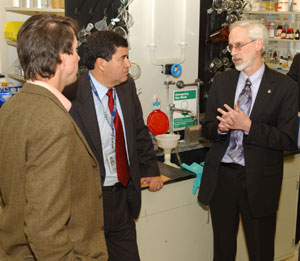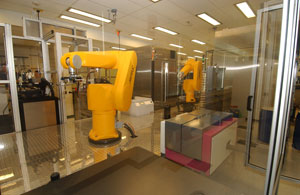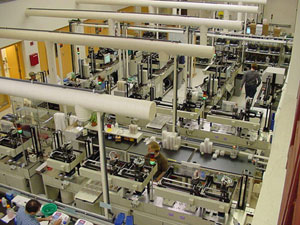
Environmental Factor, March 2008, National Institute of Environmental Health Sciences
Trans-Agency Agreement to Transform Environmental Health Protection
By Robin Mackar and Eddy Ball
March 2008




Recent advances in science and technology now make it possible to improve how scientists evaluate the health risks posed by chemicals found in the environment. During a press teleconference on February 14, NIH Director Elias A. Zerhouni, M.D., and NIEHS Acting Director Sam Wilson, M.D., joined with leading scientists from NIEHS, the National Human Genome Research Institute (NHGRI) and the U.S. Environmental Protection Agency (EPA) to announce a new collaborative agreement intended to take advantage of new technologies and shift the protocol for toxicity assessments from laboratory animal studies to more cell- based tests.
The concept behind this agreement was highlighted in paper published as the Policy Forum of the Feb. 15, 2008 issue of the journal Science. The article was jointly authored by NHGRI Director Francis Collins, M.D., Ph.D., Assistant Administrator of EPA’s Office of Research and Development George Gray, Ph.D., and John Bucher, Ph.D., associate director of the National Toxicology Program (NTP), which is headquartered at NIEHS.
NIEHS and NHGRI signed a five-year Memorandum of Understanding (MOU) with the EPA to use the NIH Chemical Genomics Center’s (NCGC) high-speed, automated screening robots to test suspected toxic compounds using cells and isolated molecular targets instead of laboratory animals. This new, trans-agency collaboration is anticipated to generate data more relevant to humans; expand the number of chemicals that are tested; and reduce the time, money and number of animals involved in testing. Full implementation of the anticipated paradigm shift in toxicity testing will require validation of the new approaches, a substantial effort that could consume many years.
The MOU builds on the experimental toxicology expertise of the NTP, the quantitative high-throughput screening technology at NCGC, managed by NHGRI (http://genome.gov/) ![]() , and the computational toxicology capabilities at the EPA’s recently formed National Center for Computational Toxicology (NCCT) (http://www.epa.gov/ncct/)
, and the computational toxicology capabilities at the EPA’s recently formed National Center for Computational Toxicology (NCCT) (http://www.epa.gov/ncct/) ![]() .
.
The agreement addresses opportunities for coordination in four basic areas related to achieving the toxicant testing goals: identification of toxicity pathways; selection of chemicals for testing; analysis and interpretation of data; and outreach to scientific and regulatory communities. The collective budget is yet to be determined.
“The experimental and computational expertise required to transform toxicology is an enormous undertaking and too great for any of our existing organizations to accomplish alone,” added. Bucher. “This collaborative approach allows us to draw on our individual strengths and establishes a long-term, multiple U.S. federal agency commitment.” NTP will contribute thousands of compounds for testing. NTP’s animal toxicology expertise will be utilized, along with a large database of the chemicals’ effects on animals, with which the new cell-based data will be compared.
“A central component of federal effort will explore the use of high-throughput screening assays in toxicology,” Collins explained. “Such assays allow for the testing of thousands to hundreds of thousands of chemicals a day to determine their possible toxic effect.” NCGC is part of a larger Molecular Libraries Imaging Program within the NIH Roadmap for Medical Research. It was designed to advance research on molecules from which most medicines marketed today are derived.
“As our detailed research strategy continues to develop, we will welcome the participation of other federal partners, as well as interested public and private sector organizations, to make this vision of 21st century toxicology a reality” Gray observed. The EPA’s engagement in this collaboration is part of its ToxCast™ program—an initiative launched in 2007 to integrate advances in computers, genomics and cellular biology into the agency's chemical toxicity evaluation procedures.
Also participating in the press conference were Robert Kavlock, Ph.D., director of the National Center for Computational Toxicology (NCCT), Office of Research and Development, EPA, Christopher Austin, director of the NIH Chemical Genomics Center, and Raymond Tice, Ph.D., acting chief of the NTP Biomolecular Screening Branch.
The Agreement in Context
The MOU and the plans articulated in the Science article provide a framework to implement the long-range vision outlined in the 2007 National Research Council (NRC) report, Toxicity Testing in the 21st Century: A Vision and a Strategy (http://dels.nas.edu/dels/rpt_briefs/Toxicity_Testing_final.pdf) ![]()
![]() , which proposed a collaborative effort across the toxicology community to rely less on animal studies and more on in vitro tests using human cells and cellular components to identify chemicals with toxic effects. Importantly, the strategy calls for improvements in dose-response research, which will help predict toxicity at exposures that humans may encounter.
, which proposed a collaborative effort across the toxicology community to rely less on animal studies and more on in vitro tests using human cells and cellular components to identify chemicals with toxic effects. Importantly, the strategy calls for improvements in dose-response research, which will help predict toxicity at exposures that humans may encounter.
Data collection to determine chemical toxicity currently relies heavily on whole-animal tests. The growing number of new chemicals, adding to a backlog of thousands that have yet to be thoroughly assessed, high testing costs and public unease with animal testing led to the search for alternate toxicology testing methods. Quantitative high-throughput screening (qHTS), developed at NCGC, increases the rate at which chemicals are tested, and profiles compounds over a wide range of concentrations.
These qualities make the new qHTS technology ideal for toxicology testing, with the potential for advancing the goal of more accurate and timely public health decisions. According to the Science article, the screening of >100,000 per day with HTS performed on automated platforms is routine in drug discovery. NHGRI has posted photos and videos of automated equipment (http://genome.gov/pressDisplay.cfm?photoID=20030) ![]() at the NCGC facility.
at the NCGC facility.
By pooling resources and forming a working partnership, the agreement overcomes the resource limitations of a single agency, builds on existing expertise and avoids the need to create a new administrative and support structure for the effort.
"Wilson Updates..." - previous story ![]()
![]() next story - "NCCU Chancellor..."
next story - "NCCU Chancellor..."
March 2008 Cover Page



